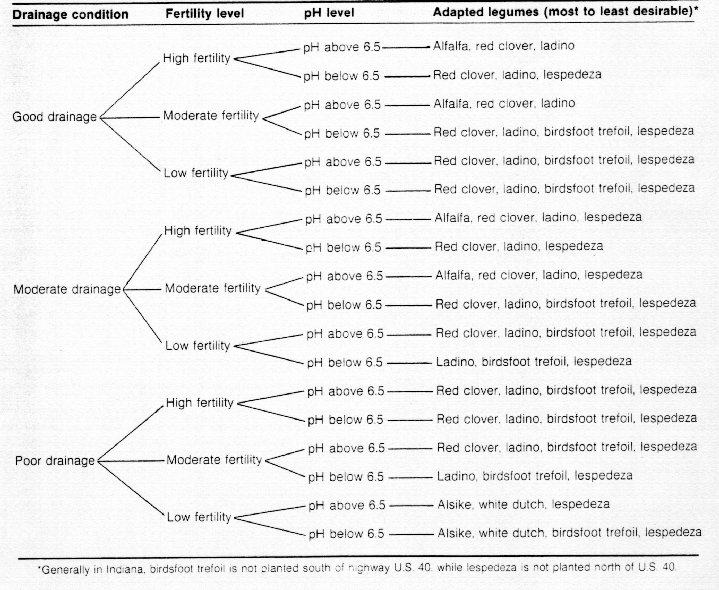
AY-211

High yield and quality are the goals of anyone growing hay and pasture crops. Research and experience show that one way these goals can be achieved is with the use of nitrogen-producing legumes, either alone or in combination with grasses.
A Minnesota study confirms the yield advantages of legumes and legume mixtures over pure grass stands (Table 1). Produced under the same conditions, alfalfa or alfalfa-grass combination was shown to give the best results. Grass alone did not begin to match the legume or mixture yields unless fertilized with 100-200 pounds of nitrogen per acre. Similar results would be expected under Indiana conditions.
Merely adding a legume to grass does not, however, guarantee better quality and yield. But chances are it will if it's the highest producing species capable of thriving in a given field.
Yield as per-
cent of alfalfa-
Crop or crop mixture grass yield
--------------------------------------------------------
Alfalfa or alfalfa-grass mixture 100%
Red clover or red clover-grass mixture 85-95%
Alsike clover or ladino-grass mixture 60-70%
Birdsfoot trefoil 65-75%
Pure grass, no nitrogen fertilizer 30-40%
Pure grass, 50 lbs. nitrogen/acre/year 40-50%
Pure grass, 100 lbs. nitrogen/acre/year 60-70%
Pure grass, 200 lbs. nitrogen/acre/year 90-100%
--------------------------------------------------------
Primarily, three soil traits dictate what legume will likely grow best on hay and pasture land in Indiana. They are: drainage, fertility and pH (degree of acidity). Presented here is a procedure for selecting that legume species best suited to a field based on its particular combination of these three soil traits.
1.Take soil samples from the field to be planted, and have them analyzed for fertility and pH levels. See your County Extension Office for soil sampling instructions and needed materials.
2.While taking the samples, inspect the field for its surface and internal drainage conditions. In general, bright red, yellow or brown soils that are uniform in color are well drained; whereas gray or dark soils with a mixture of color are more apt to be poorly drained. Consult County Extension or Soil Conservation Service personnel if you need help in determining the drainage rating.
3.Based on the field survey and soil test results, "read" Table 2 to find what legumes are adapted to your field. Beginning with the "drainage condition" column, select the soil drainage situation (good, moderate or poor) that best describes the field. Next, move to the "fertility level" column, and choose the appropriate soil fertility condition (high, moderate or low) under that , particular drainage category. Then follow on to the pH level" column and find the pH measure (above 6.5 or below 6.5) that describes the field.
4.Finally, from the "adapted legume" column, select the species best suited to your situation. The column shows the three or four legumes that are adapted to the specific combination of soil traits just enumerated in the order of desirability--i.e., first species listed is the most desirable, the second is next most desirable. etc.
Normally, you would choose the first one listed; but you may have to b-pass it for some reason, such as seed not available locally, insects being too much of a problem. etc. In that case, the second species listed would be considered, then the third and finally the fourth.

RR 5/89
Cooperative Extension Work in Agriculture and Home Economics, State of Indiana, Purdue University and U.S. Department of Agriculture Cooperating. H.A. Wadsworth, Director, West Lafayette, IN. Issued in furtherance of the Acts of May 8 and June 30, 1914. It is the policy of the Cooperative Extension Service of Purdue University that all persons shall have equal opportunity and access to our programs and facilities.